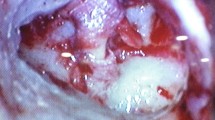Summary
Conservative tympanoplastic procedures in 210 clinical cases of chronic suppurative otitis media and tympanosclerosis have shown granulation tissues to be present within the aditus often to the extent that antrum and tympanic cavity were virtually separated from each other; i.e., there was an occlusion of the aditus. Attempts were made to pinpoint the etiological factors involved by means of inframacroscopic examinations of embryonic and adult temporal bones, supported by observations made during surgery. The study of embryological temporal bones indicated a special role of the aditus during the development of the temporal bone. In adults, it is apparently the complex fine structure of the aditus, as described in the present paper, that aids the retention of secretions and the formation of granulation tissues.
Zusammenfassung
Auf Grund von in 210 Fällen durchgeführten konservativen tympanoplastischen Eingriffen haben die Verfassergefunden, daß bei chronischer Otorrhöe sowie bei Tympanosklerose das Granulationsgewebe des Aditus so massiv entwickelt and derart gelagert sein kann, daß dadurch Antrum und Paukenhöhle voneinander getrennt werden. In diesen Fällen kommt es zu einem Aditus-Verschluß einer Occlusio aditus. Die Verfasser trachteten die ätiologischen Faktoren durch inframakroskopische Untersuchungen der Felsenbeine von Embryonen und Erwachsenen, ferner durch Erfahrungen bei Eingriffen zu klären. Untersuchungen embryonaler Felsenbeine zeigen, daß der Aditus bei der Entwicklung eine besondere Rolle spielt. Bei Erwachsenen diirfte die komplizierte Feinstruktur des Aditus, die hier beschrieben wird, die Retention von Sekret and Bildung von Granulationen begünstigen.
Similar content being viewed by others
Literatur
Bollobás, B.: Die Bedeutung eines Zugangs zum pathologischen Innenohr bei Otitiden im Säuglings- und Kleinkindalter (Ung.) Magy. Sebész. 6, 461–467 (1954).
- Theses scient. Budapest 1970.
Dworacek, H.: Die anatomischen Verháltnisse des Mittelohres unter operationsmikroskopischer Betrachtung. Acta, otolaryng. (Stockh.) 51, 15–45 (1960).
Gerlach, H.: Die hintere Gehörgangswand bei der Tympanoplastik. Z. Laryng. Rhinol. 48, 214–218 (1969).
Jansen, C.: Über Verwendung von Knorpel bei chronisch-entzündlichen Prozessen beider Mittelohren. VII. Internat. Kongreß, Paris 1961.
Moritz, W.: Hörverbessernde Operationen bei chronisch-entzündlichen Prozessen beider Mittelohren. Z. Laryng. Rhinol. 29, 578–583 (1950).
Proctor, B.: Chronic middle ear disease. Arch. Otolaryng. 77, 276–283 (1963).
−: The development of the middle ear spaces and their surgical significance. J. Laryng. 78, 631–648 (1964).
Struzewski, B.: Variabilität der Struktur der rückwärtigen Teile der Gehörknöchelchen der menschlichen Tympanonhohle (Tschech.). Warsawa: Panstw. Zaklad. Wyd. Lekarsk 1968.
Wullstein, H.: Technica e risultati della timpanoplastica. Arch. ital. Otol. 65, 757–785 (1954).
Zöllner, F.: Hörverbessernde Operation bei entziindlich bedingten Mittelohrveränderungen. Arch. Ohr-, Nas-. u. Kehlk.-Heilk. 171, 1–62 (1957).
Author information
Authors and Affiliations
Rights and permissions
About this article
Cite this article
Bollobás, B., Hajdu, I. Ätiologische faktoren beim aditus-verschluß (Occlusio aditus). Arch. Klin. Exp. Ohr.-, Nas.- U. Kehlk. Heilk. 198, 350–359 (1971). https://doi.org/10.1007/BF00316935
Received:
Issue Date:
DOI: https://doi.org/10.1007/BF00316935



